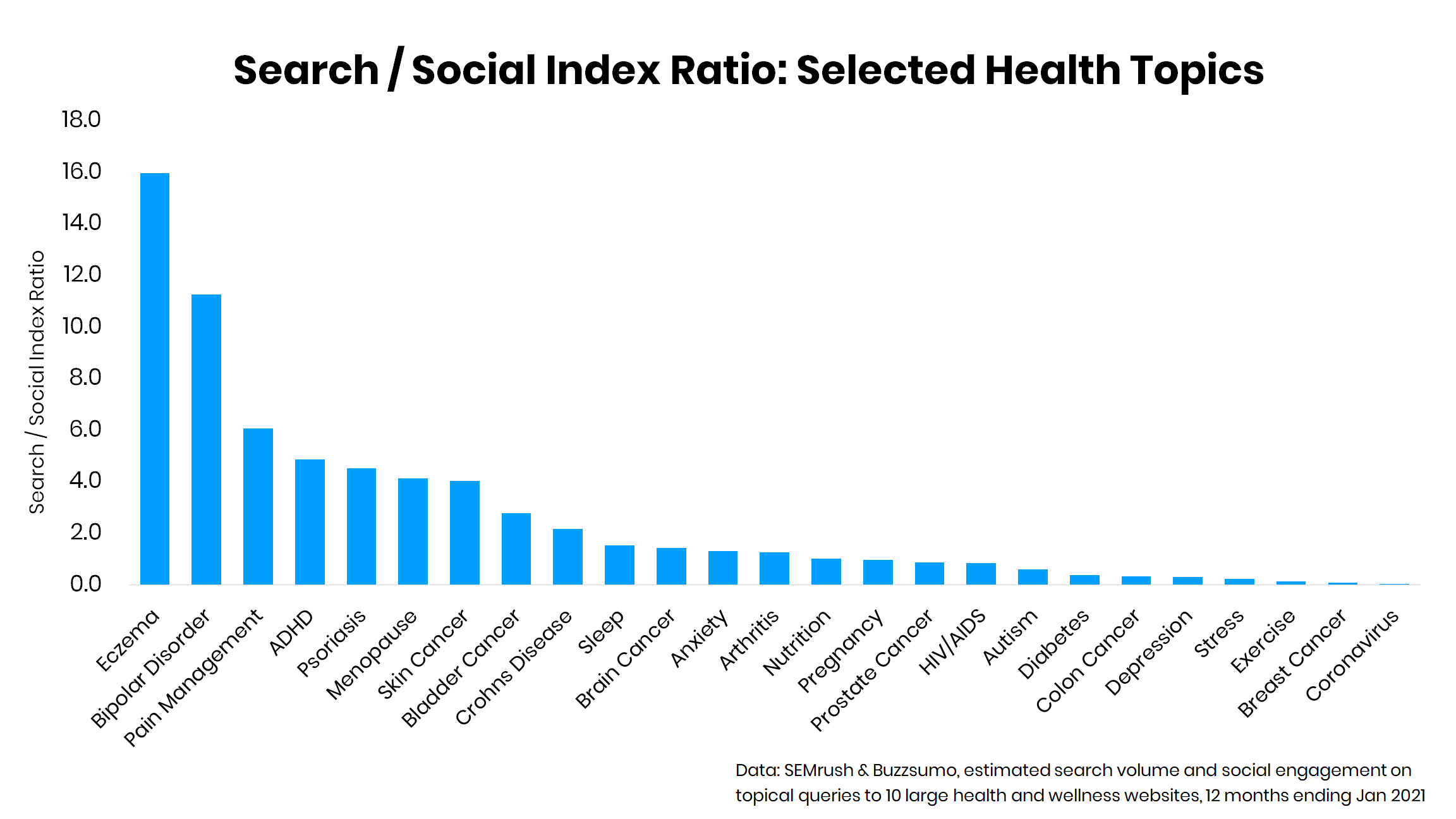Health content, stigma and the impact on your channel strategy
When planning your content marketing efforts, map your topics to the appropriate channels your audience uses
Have you ever tried to find information about an embarrassing health issue? Something you wouldn’t want to share with your friends or acquaintances?
Of course you have — and like most people, you probably did it through a search engine. Google is a repository of a seemingly uncountable number of queries on topics we’d prefer not to broadcast to the world.
Not all health conditions are created equal, and people will react to those conditions differently. Some conditions carry a stigma that makes it unappealing to share a personal experience on a social platform. Or publicly share the fact that you have it in the first place. Naturally, engagement with high-stigma conditions tends to cluster on search, while engagement with low-stigma conditions tends to cluster on social platforms.
For marketers, creating a channel map is a great way to systemize thinking around which content fits which traffic channel or audience. And for healthcare marketers, it’s worth knowing which conditions will match audience expectations with each channel.
We used search data from SEMrush and social data from Buzzsumo to look at 25 health conditions through the lens of 10 of the largest health news and information websites (>30M visits/month) — indexed for relative search and social performance — to see which conditions trend toward search interaction and which trend toward public social engagement. We’ve summarized this as a ratio (as you can see in the chart below): dividing a given topic’s search index ranking among topics within the dataset by that same topic’s social index ranking. Conditions with a value greater than one are more likely to overperform in search, conditions with a value less than one are more likely to overperform in social.

This lines up with what you might expect to see in your own health journey: you might be more willing to share articles on the topic of exercise routine of choice as opposed to, say, that odd flare of pain you’ve had in your stomach over the last week. Here’s how we interpreted the results across the dataset:
Which topics trend toward search?
- Skin conditions, including skin cancer: Conditions with these visible skin symptoms were the most biased toward search traffic compared to others
- Mental health disorders such as ADHD and bipolar disorder: This is not uniform — while these two conditions in particular appear to be biased toward search, the pandemic has normalized expression of stress and depression, both of which were elevated in social conversations in 2020
- Pain symptoms: Some types of pain may be more affected by stigma than others, especially those dealing with sex-specific conditions
- Menopause: An ever-present condition that is nevertheless affected by both the implicit and explicit stigma associated with age
Which topics trend toward social?
- Coronavirus: It’s everywhere — from conversations about virus symptoms and treatment, to the social and political implications of the last year, to emerging topics around vaccination and post-pandemic life
- High-awareness conditions, such as breast and colon cancer: There is no doubt that comfort in discussing specific cancer-related subjects varies, but recent awareness campaigns have driven these particular conditions out into the open
- Diabetes: As this condition has become more prevalent in the United States and awareness campaigns have taken root, social conversation on signs, symptoms, and treatment has become more common
- Diet and nutrition: Health websites have leaned into the food beat as a subject area that may be relevant to the broadest possible audience, and readers are engaging accordingly on social platforms
- Exercise and fitness: Workouts are now often promoted as shared experiences, with a greater emphasis on workout apps, classes, and advice/recommendations
What can healthcare marketers take away from this?
- Calibrate expectations of what social can do for high-stigma topics. Even with a large social media presence, your audience isn’t necessarily going to want to engage with these topics in the same way as with diet or fitness-related content.
- Invest in private discovery mechanisms for high-stigma topics. SEO should be a major priority as a content discovery pathway for any stigma-related topic. And it may be worthwhile to explore community-building within private groups, such as Facebook groups or subreddits that discuss these topics.
- An investment in low-stigma topics can help gain traction on social platforms. People can and do share and engage with general health and wellness content, from lifestyle tips to healthy recipes. Even if you are more focused on other areas or specific conditions, dedicating a portion of your content marketing efforts on other verticals can increase your social reach and offer opportunities for engagement between “spiking” health moments.
- Conditions will evolve as stigmas are erased. Awareness campaigns have played an important role in destigmatizing conditions, and the more we see them, the more engagement will shift from private channels (including search) to public forums.
By better understanding the context — and mindset — surrounding your audience’s needs in a given moment, you can do a better job of meeting them where they are, serving them with the content tailored to that moment, and offer an empathetic next step toward a deeper connection with your organization. R
Revmade offers services that unearth that context and those possible connection points — get in touch to learn how we can help.
Subscribe
Get our weekly newsletter for tips on how to drive better content marketing performance.
For a regular stream of ideas, research and links we find helpful. And of course, to say hi!
